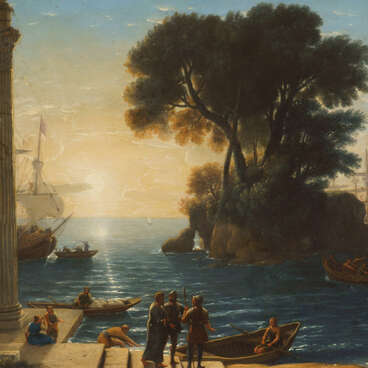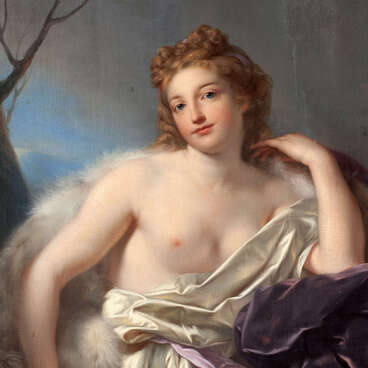Carlo Maratti (Maratta) was an Italian Baroque painter and architect who belonged to the Roman school of painting. From the age of 12 he was apprenticed to the academic master Andrea Sacchi. He painted in the traditions originating in the works of Raphael.
At the end of the 17th century, Maratti became one of Italy’s leading artists. In 1700 he was appointed president of the Academy of Saint Luke in Rome, ran an enormous studio, was knighted, awarded the order of the Church and listed as a court painter by Louis XIV, who encouraged him to live and create in Rome.
Besides altarpieces for churches, Maratti also created portraits, frescoes, sculptures, and worked on paintings based on ancient Greek myths. The painting “Acis and Galatea” was inspired by one of the most popular stories in European art, told by Ovid in the “Metamorphoses”.
The legend is set in Sicily. The beautiful sea nymph Galatea and the young man Acis fell in love with each other. But Polyphemus the Cyclops, a one-eyed monster, was also very much in love with Galatea. One day, when he was with his flock on the slope of the volcano Etna, he saw the lovers together. Enraged, the Cyclops tore off a piece of rock and threw it at Acis. The young man’s blood poured out in a torrent from under the mountain. Gradually it became a clear river and flowed into the sea, where the souls of Acis and Galatea were united again.
Maratti interprets this tragic subject in quite a cheerful way, even triumph one: Galatea and Acis recline calmly and majestically on the shore, and the inhabitants of the depths bring them the gifts of the sea — corals and pearls in an enormous shell. Above the lovers’ heads are numerous putti —winged infants, a frequent decorative motif in the art of the Italian Renaissance.
The corpulent nude Galatea with her snow-white skin and the tanned Acis with his muscular figure embody the academic formula of the ideal: forza, grazia, decorum — strength, grace, beauty. Maratti adopted this motto, and the artist adhered to it throughout his career in art. It is not without reason that his later work is defined as Baroque academism.
At the end of the 17th century, Maratti became one of Italy’s leading artists. In 1700 he was appointed president of the Academy of Saint Luke in Rome, ran an enormous studio, was knighted, awarded the order of the Church and listed as a court painter by Louis XIV, who encouraged him to live and create in Rome.
Besides altarpieces for churches, Maratti also created portraits, frescoes, sculptures, and worked on paintings based on ancient Greek myths. The painting “Acis and Galatea” was inspired by one of the most popular stories in European art, told by Ovid in the “Metamorphoses”.
The legend is set in Sicily. The beautiful sea nymph Galatea and the young man Acis fell in love with each other. But Polyphemus the Cyclops, a one-eyed monster, was also very much in love with Galatea. One day, when he was with his flock on the slope of the volcano Etna, he saw the lovers together. Enraged, the Cyclops tore off a piece of rock and threw it at Acis. The young man’s blood poured out in a torrent from under the mountain. Gradually it became a clear river and flowed into the sea, where the souls of Acis and Galatea were united again.
Maratti interprets this tragic subject in quite a cheerful way, even triumph one: Galatea and Acis recline calmly and majestically on the shore, and the inhabitants of the depths bring them the gifts of the sea — corals and pearls in an enormous shell. Above the lovers’ heads are numerous putti —winged infants, a frequent decorative motif in the art of the Italian Renaissance.
The corpulent nude Galatea with her snow-white skin and the tanned Acis with his muscular figure embody the academic formula of the ideal: forza, grazia, decorum — strength, grace, beauty. Maratti adopted this motto, and the artist adhered to it throughout his career in art. It is not without reason that his later work is defined as Baroque academism.



